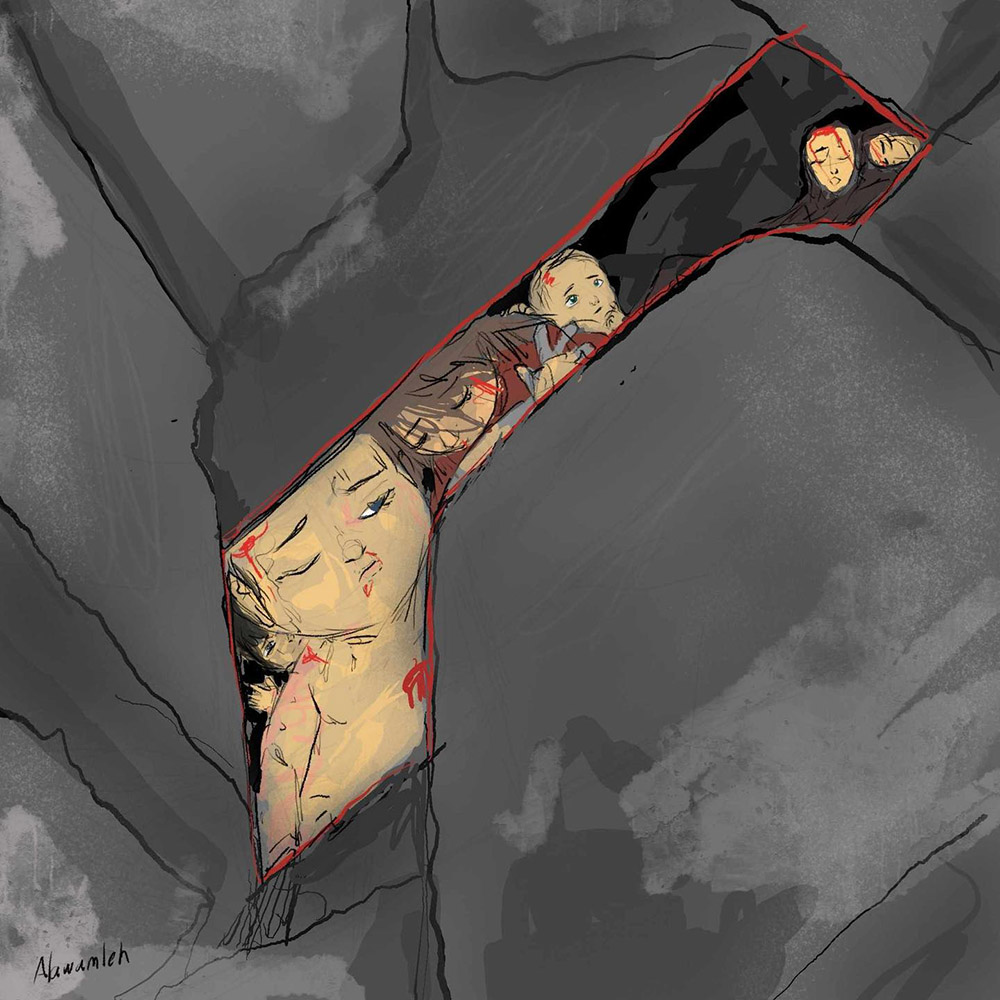Opinions published in The Markaz Review reflect the perspective of their authors and do not necessarily represent TMR.
UC Irvine scholar and author on the Middle East Mark LeVine warns that this Gaza war is biting off more than anyone is bargaining for.
Mark LeVine
I will not soon forget the morning of October 7. I woke up and, still bleary-eyed, scrolled on Facebook just to see the latest from friends. What I saw instead was various artwork of hang-gliders and kites flying towards the sun, as well as a suddenly ubiquitous, beautiful painting of a bulldozer crashing through a fence. I recognized these as somehow referencing Palestine, and my immediate thought was, “My God, they’ve finally done it. They broke out of Gaza. The real ‘March of Return’ has begun.”
For those who don’t know about it, the “Great March of Return” was a massive but largely symbolic march by Palestinians to the heavily policed border zones encircling and imprisoning Gaza in 2018-19 to remind the world of Gaza’s present plight and roots in the expulsion of hundreds of thousands of Palestinians from their homes in what became Israel in 1948. Israeli forces, as always, responded with massive force, killing almost 300 people and injured over 10,000. My Palestinian friends in Gaza, where I’ve worked as a journalist and researcher for almost 30 years, had long talked about such a march, but until 2018 Hamas largely prevented it, because a massive act of anti-colonial civil disobedience was not on brand, not something they knew how to manage or control. Indeed, it called the movement’s entire modus operandi of spectacular attacks on civilians into question. But the pressure of almost two decades of siege proved too much and ultimately Hamas had little choice but to let it happen, and then largely stood by as Israel responded in its usual manner.
Using a bulldozer, the symbol of the Israeli occupation, deployed both to destroy Palestinian homes and olive trees and to build settlements, to break through an ostensibly impregnable security fence was brilliant. Still, as I made my coffee and tried to wake up my eyes, I feared for the marchers I presumed were streaming through the fence, and hoped they might be joined by Israeli peace activists, as had occurred at other marches in the West Bank, and get a few kilometers into Israel before the IDF stopped and began arresting them, or worse.
When I came back to my phone a half hour later, however, new images began appearing, this time photos of Israelis with Hebrew text underneath, including a photo of a brilliant young postdoc named Haim Katsman, whom I’d informally advised during his doctoral research at the University of Washington. My first thought was that he’d just won a prize for his work or got hired somewhere, but when I read the Hebrew it became clear that photo was a memorial, not a celebration. It also became clear that Haim had been murdered in an unprecedented Hamas attack on Israeli civilians and soldiers in the vicinity of Gaza that was still unfolding, and whose extent was just becoming clear. Suddenly, the meaning of the gliders, kites and bulldozers became clear. They didn’t symbolize broad hopes for freedom, or a mass civil disobedience action. They indicated the launching of a war by Hamas against Israel, against any Israeli they could find, including one of the most anti-occupation activists I’d ever met, Haim Katsman. The beginning of a total war. I quickly put up a post in tribute to Haim, and other peace activists I knew who’d been killed or kidnapped, and hoped — although I knew better — that it wouldn’t be the first of an unending stream of tributes to Israeli and Palestinian friends, colleagues and comrades lost to violence in the coming period.
At that moment, as the numbers of Israeli dead and kidnapped seemed to double by the hour and images and video posted by Hamas of their attacks began to circulate, I also knew what was coming: an unprecedented Israeli response that would likely decimate Gaza, kill upwards of tens of thousands of people, and potentially lead to the forced flight of hundreds of thousands of inhabitants across the border to Egypt. This was in fact a long held and well-known Israeli goal, if an unrealizable one under normal circumstances: if enough Gazans could be forced out of the Strip, Israel could annex the entirety of the Occupied Territories and even give Palestinians some form of citizenship without tipping the demographic balance in their favor. End of Palestine, end of conflict. Israel has long claimed “Palestinians never miss an opportunity to miss an opportunity” for peace; it would not let this opportunity pass to change the balance of people, and forces, permanently, especially after suffering such a horrific and humiliating attack by a group it thought it had bought off.
None of the artwork produced in real time of and by Palestinians depicting them gliding and bulldozing towards the sun, towards freedom, included weapons. They were almost hallucinatory in their impressionism. Perhaps it’s because the artists implicitly understood that the guns would not bring freedom, but only mass death on all sides, and could not bear to include them. Or perhaps the artists of the first images didn’t know what was happening when they made the art (the first images of people streaming through the fence showed them with bicycles and backpacks, not AK-47s or RPGs). Either way, the absence was telling, and in fact out of the traditional revolutionary aesthetic of Palestinian resistance art. Indeed, in previous hang glider attacks (which usually occurred from Lebanese soil), the artwork clearly included AK-47s held by the gliders. Leila Khaled, the most (in)famous Palestinian freedom fighter/terrorist outside Yasser Arafat, was almost never depicted without her AK or her keffiyeh. Arafat himself famously came to the UN “with an olive branch and a gun.”

But these were the days when Palestinians still enjoyed the support of the Soviet Union and other supposedly “anti-colonial” regimes like Saddam, Ghaddafi or Assad. The AK was still a near universal symbol of liberation struggles globally, the great equalizer against the far more sophisticated weaponry of the imperialist or (neo)colonial oppressors. Their absence said everything that I needed to know about the lack of imagination amongst all sides today. Palestinians have been using non-violent civil resistance for decades to slow down the relentless occupation. Most everyone who has led that movement has been imprisoned, exiled or killed. To this day, every day, they continue such struggles, now largely out of view of the world as Israel has managed to prevent Israeli and international activists from joining these actions as they did in the past, enabling far more force to be deployed against them in return. At the same time, Hamas has never seen militant non-violence as a useful tool. It’s simply outside the movement’s extremely limited worldview and way of thinking and being. I interviewed spokesman Ghazi Hamad in Gaza in 2002 or 2003, during the wave of suicide bombings that completely derailed the al-Aqsa Intifada, and when I asked him point-blank why Hamas relied entirely on a tactic that only succeeded in getting more Palestinians killed, more homes bulldozed, and more land expropriated, he shrugged and responded, “We know the violence doesn’t work, but we don’t know what else to do.”
In the ensuing two decades, needless to say, Hamas didn’t bother to make up for lost time learning new tactics. In fact, after it took control of Gaza in 2006, Hamas forces regularly prevented non-violent protests from occurring. When young Gazans marched to Erez check point, it was Hamas gunmen who stopped them from getting close, not Israeli forces. When Gazans tried to organize new youth-led movements for change, it was Hamas that harassed the activists and forced many of them into exile. The movement retained its singular vision of spectacular confrontation with Israel, even as it coordinated with Israel to maintain some semblance of peace, punctuated by occasional spams of rocket-fire that would lead to Israel’s “mowing the lawn” in response, destroying a few neighborhoods and killing a couple of thousand people. Acceptable casualties, apparently, to maintain a status quo that kept them in power and on the money train from the Gulf arriving on schedule — even as successive Israeli governments openly declared paying off Hamas was the best strategy to keep Palestinians divided and foreclose any possibility of a two-state solution.
Well, no one’s bothering to “mow the lawn” today. Hamas’s October 7 attack was one of the worst acts of terrorism in half a century, joining September 11 as a date that will live in infamy not just in Israel but in the West, which saw the echoes of bin Laden, and ISIS in the live-streamed indiscriminate mass murder of civilians (and hundreds of soldiers as well). Whatever the rationality behind and justifying it in the minds of Hamas leaders and fighters (interviews with Hamas leaders in the Arab media report the movement feared an Israeli takeover of the al-Aqsa compound was imminent, among other fears), this action could only be interpreted as the start of a total war, a no holds barred conflict where any remaining respect for international humanitarian law and human rights, for civilian lives and safety, would be buried beneath rivers of blood and piles of rubble and corpses. Activists have long complained that Israel has used and abused international law to its advantage. We were all about to find out what happens when it doesn’t even bother to pay it lip service.
Here’s the thing about total war: when the “gloves come off,” when all rules of engagement are removed, the stronger side usually wins, and genocide begins to come into view. If Israel’s historic response to Palestinian attacks has been a 10-1 ratio of dead and far more injured, October 7 would surely skew that number even more. 15 or 20 to 1 was more likely, and as the days have turned to weeks and now a month, the meaning of that ratio becomes clear with a humanitarian catastrophe that even seasoned conflict zone reporters, UN personnel and diplomats, who are used to seeing such carnage, are having trouble finding the words to describe.
Especially in colonial situations, where the colonizer has spent decades dehumanizing the colonized, providing an opportunity to act out that deep-seated dehumanization with massive fire power outside the home territory where its more constrained laws must operate if society is to function, almost always leads to scenes that normal people can’t find the words to describe. They literally have to lead to this, because the attack on its people cannot go unanswered without completely delegitimizing the entire enterprise. As well, “finishing the job” becomes an equally horrific possibility – in this case, the job of 1948, of forcing enough Palestinians out of the Occupied Territories permanently to foreclose any possibility of independence in the foreseeable future.
At the same time, the fact that in the days after October 7, Israel initiated the single most successful land-grab since 1967, in the Bedouin areas of the West Bank that Israel has long coveted and refused to give Palestinians any control over, reminds us that in the end Gaza has always served as both distraction and tool; the real prize has always remained East Jerusalem and the West Bank heartlands of “Biblical Israel”; whenever violence in and from Gaza has flared, land seizures almost always occur along with it.
As Israel’s response continues unabated I fear that Israel-Palestine has entered its total war phase, a World War II in miniature, with the goal of each side being to kill enough civilians on the other side to force surrender or at least a negotiated settlement closer to one’s acceptable terms.
The horrible calculus of total war is that the more violence either side suffers, the more it will have to use in response to justify its dead. And Israel has a lot more firepower than Palestinians, a massive strategic advantage, and now a seemingly existential reason to throw any semblance of respect for international law to the wind. And the West, sensing this is a defining “us-and-them” moment, is taking Israel’s side, not just against Hamas, or even all Palestinians, but against anyone, including their own citizens, who challenges the official policy of unquestioned support for whatever force Israel uses to destroy any Palestinian opposition. It’s clear Biden, Macron, Trudeau, Scholtz, Sunak, Albanese and other leaders of the former (and indeed, often still active) settler colonial powers that comprise the West see this as an inflection point, no doubt in the context of a fast approaching climate change tipping point which will put upwards of 2 billion people from the Global South on the move, first to their own coastal cities (if they have them), and as they become uninhabitable, to the North — something that under no circumstances can be allowed to transpire. Watching comfortably from the sidelines, Russia, India and China couldn’t be more satisfied. Indian PM Modi is even putting up memes showing him single-handedly defeating Hamas, a useful proxy for the Muslim Indians more of whose rights he’s taking away every day. With international law all but ignored, every great and middling power can ignore it as well without fear of criticism, never mind repercussions.
These are the ultimate stakes involved in the current Israel-Gaza war.
If we owe the dead anything — and there’s going to be even more dead to which we owe much in the coming days, weeks, and months — it’s clear-headed honesty. Everyone needs to understand the stakes. This is a war for the future of humanity; it goes way beyond just the future of Palestine and Israel, and directly relates to our ongoing collective failure to meaningfully address the rapidly approaching global warming tipping point, beyond which there is no scenario that is not catastrophic for all but the globally privileged few. Because of this, if this war is not stopped NOW, and real negotiations towards full freedom and justice for everyone, including environmental justice and sustainability, between the Jordan River and the Mediterranean — and indeed, for everyone everywhere — what we see in Gaza and all of Palestine and Israel will be coming our way before we know it.





Hi Mark, this is one of the most thoughtful pieces I have read on the war. Many thanks for sharing it.